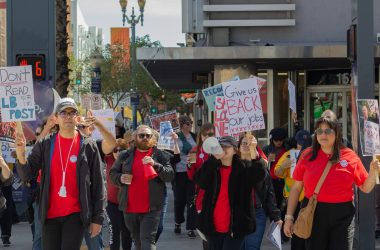
On the night of Nov. 20 at the Standing Rock Indian Reservation in North Dakota, Kylie Shahar and Amanda Mendoza stood in disbelief as they saw individuals being blasted by water cannons in freezing temperatures, shot at with rubber bullets and blinded by tear gas.
Just having arrived at the Oceti Sakowin campsite earlier that day, the Cal State Long Beach students were two of many protesters that night who helped those who were soaked in freezing water change into dry and warm clothing, keeping them from suffering from hypothermia.
Shahar, a senior philosophy and political science major, and Mendoza, a political science graduate student, said that when they first heard about the Dakota Access Pipeline movement, they knew they had to be there and participate.
The Standing Rock Sioux Tribe started protesting the construction in April, fearing that the pipeline could contaminate their drinking water if it were to burst.
Additionally, protesters say that the construction will threaten the environment and destroy native burial and prayer sites.
“We were there for about six days,” Mendoza said. “We drove in my parent’s suburban and stayed from Nov. 20-25.”
Shahar and Mendoza met for the first time on Nov. 7 via a mutual friend.
“None of my classmates or colleagues wanted to go with me, so a friend of mine had a class with Kylie and introduced us to each other,” Mendoza said. “We had to see if we would vibe because you needed to go with someone you can trust.”
Mendoza expressed that she needed someone who could handle the pressure, especially if she ended up getting arrested.
“We knew within five minutes of meeting that it was going to be great,” Mendoza said.
Shahar and Mendoza funded the trip on their own. While no fundraising was done beforehand, they were able to receive some financial support from Mendoza’s parents.
“Our intention was to have a short stay,” Mendoza said. “We just pooled our money and split the gas money. We also had some gear lent to me by my parents.”
College of Liberal Arts professor and chair of the political science department Teresa Wright sent out an email to faculty on Nov. 14 asking faculty and students to donate winter coats, sleeping bags and any canned foods for Shahar and Mendoza to take to the camp.
“We took a box of donations from campus, which included a couple jackets, some food and bathroom essentials,” Mendoza said.
“We also picked up four large boxes of canned food and a large box of winter coats from Micha’s Way, a non-profit in Santa Ana, and donated their items to camp on their behalf.”
Shahar and Mendoza repeatedly said that they had no idea what to expect when traveling to the Standing Rock reservation. It took them two days to drive to the location.
They treated it like a typical road trip at first. They had time to get to know each other more intimately, but it wasn’t until the day before they arrived that they remembered what the reason and focus of the trip was.
“We just knew that we had to be there and help the cause,” Mendoza said. “As soon as we arrived at the campsite, we said it was our first time there and the indigenous woman who received us said ‘welcome home’.”
Mendoza and Shahar described the campsite as welcoming and organized. Every morning an orientation was given in case any newcomers had arrived the day before and were explained the protocols of the reservation.
“Since it’s a land of prayer, they have protocols that teach you to respect the elders, respect the tribes and to respect the land,” Mendoza said.
Shahar explained that the non-indigenous people participating in the protest were respectful of all the protocols and customs at the reservation.
The night Mendoza and Shahar arrived was the night police shot water cannons at protesters. The CSULB students said the scene resembled a war zone.
They had just finished setting up their campsite when they were told that there was help needed at the front line.
“We just looked at eachother and said, ‘We’re here, this is what we came for,’” Shahar said. “We just stood at this hill that overlooked everything that was going on at the front lines and we were so shocked that I don’t think we said a word to each other for 45 minutes.”
Mendoza and Shahar couldn’t protest at the front line, since they hadn’t yet signed the paperwork that a volunteer group of lawyers gave to those who wanted to be at the police line.
After filling out the paperwork, the lawyers coached individuals on what to do if arrested, in addition to providing legal services and posting bail for those who did get arrested.
Mendoza and Shahar quickly helped those who were wet in freezing temperatures change out of their drenched clothes and helped provide them with warm and dry clothing.
“We would get them by the fire pits and have them drink warm liquids in order to help them stay warm,” Shahar said. “We would also pour water in the eyes of those that had been affected by tear gas or pepper spray.”
The people standing at the front lines were described by Mendoza and Shahar as unarmed and peacefully protesting.
“Many thought that the confrontation lasted a short time,” said Mendoza. “It actually lasted about six hours.”
The police were described as militarized, as they were dressed in full riot gear and shooting rubber bullets at the protesters.
“We just couldn’t believe what was happening,” Shahar said. “This was straight up police brutality.”
According to Mendoza, while some people were kept from getting hypothermia due to the freezing temperatures, some eventually fell ill.
Shahar added that other elderly people fell into cardiac arrest due to the pepper spray that police used against protesters.
Mendoza explained that her goal was to offer any support she could at Standing Rock and bring back their experience to those who couldn’t attend the protest.
Mendoza and Shahar also wanted to come back and spread awareness of the DAPL as much as possible.
“I’m an environmentalist and I want to protect mother earth as much as possible,” Shahar said. “It should be a goal for all of us.”
Mendoza said that protesting at Standing Rock was a lifechanging experience.
As of Dec. 4, the Army Corps of Engineers have halted the construction of the pipeline and are planning to reroute it.
Both Shahar and Mendoza plan on going back to Standing Rock on Dec. 17 along with a couple from Redlands and two people from Dallas that they met at Standing Rock.
Mendoza and Shahar have created a facebook page called Long Beach Water Protectors.
Additionally they have created a GoFundMe page with a goal of $2,500.




